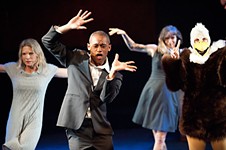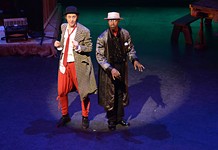Dracula: Sizzling Movement
Local Arts Reviews
Reviewed by Barbejoy A. Ponzio, Fri., April 21, 2000
Dracula: Sizzling Movement
Bass Concert Hall,
April 8
Houston Ballet's production of Dracula was effective in all the ways it was supposed to be. It set the mood with haunting, melodic music. It told a scary and seductive story. Its sets were elaborate, its Victorian-era costumes enchanting, and its dancers flying marvels. But what made this work a masterpiece? The movement. Rather than getting stuck in ballet's conventions, Houston Ballet artistic director Ben Stevenson used movement for what it is and can be. He chose movement that reinforced and embellished the dramatic content.
Here, the title character is a crafty Svengali who gains power from channeling his strength, gathering the life force of others, and taking that energy inward. He lures his victims with grand movements, and throughout the ballet, these qualities define Dracula as self-centered, consumed with a ferocious appetite and relentless determination. Nicholas Leschke performed the part with hypnotic, calculating seduction. When Dracula first appeared, he asserted power over his wives by moving his lavish, ornate cape in a languid and elegant ripple. Drawn by this magnetic pull, his brides numbly executed a sleepwalker's dance, an ethereal trance with arms extended forward, the rest of the body following. The count conjured his powers by repeatedly moving his claw-like hand upward past his throat, his mouth opened wide in readiness for the next bite. He executed full turns in the air to grab more energy, pulling it downward with him into a spider-like pose on the floor. He hesitated, posed, and sprung upward again, ready to repeat the sinuous cycle. With audacious grandeur, he walked toward the audience, his gait conveying the message "This is me. I am here. I am Count Dracula!" The audience applauded with impressed delight.
The distinctive movements bestowed on the other characters also gave them depth. Dracula's henchman Renfield, danced by Mauricio Canete with robust dramatic flair and feats of kinesthetic wizardry, was a wild, eccentric, frenzied, almost lovable character. The gestures and authentic humor of the Innkeeper embodied those of an older man; Dorio Perez showed us the quirkiness of age, while still being able to dance with zest, dignity, wisdom, and joy.
Julie Gumbinner's Svetlana possessed the sweetness and naiveté of a young maiden, and her solo of intricate pointwork was executed with velvety softness. But it was Yin Le as her beau Frederick who exuded the characteristics of youth through his dancing: unyielding confidence, strength, stamina, and power. Unfortunately, when these two lovers got together, the lifts dampened their courtship.
During the closing act, Dracula engaged Svetlana in a Dance of Death, claiming his victim with hypnotic gestures, then swooping his cape around her, propelling his body at hers, and lustfully enveloping her passive body with his. The movement between Leschke and Gumbinner was an exquisite metaphorical exchange of advance and retreat, resistance and surrender.
In the end, Svetlana was redeemed from her vampirical fate by Frederick, who pulled away the drapes to let dawn do his dirty work of destroying his undead enemy. Dracula's bloodsucking corpse sizzled into oblivion, an awesome ending to a ballet that was unbeatable in its theatrics, dancing, and choreography.








